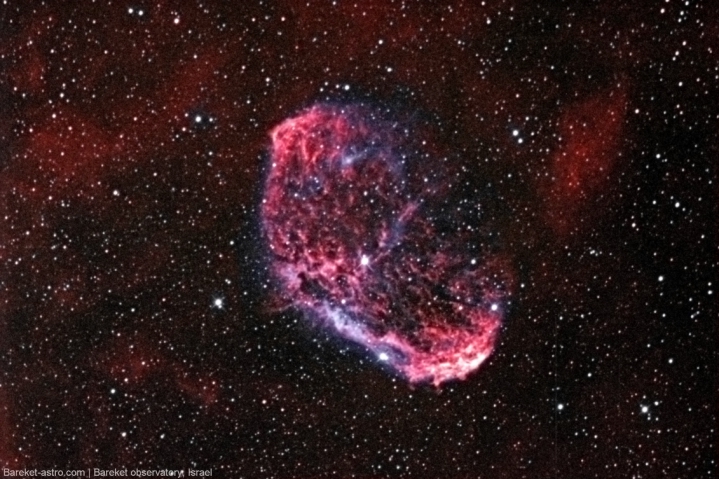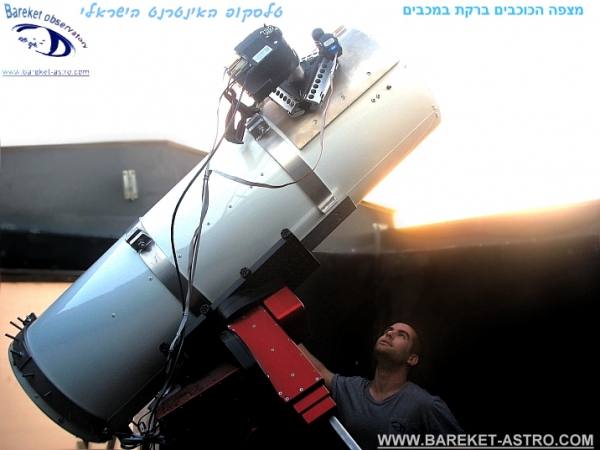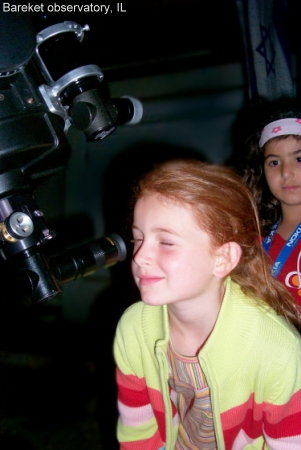Remote robotic internet telescope live CCD imaging
Bareket observatory in Israel - robotic Internet telescope is a fully remote controlled telescopic system.
Enabling a direct or autonomous control via the web, or by premade scripts.
The system's consist of a highly sophisticated telescope system that can be controlled from any place connected to the Internet.
This advanced telescopic system is open exclusively for educational and scientific projects.
See also the LIVE ASTRO-WEBCASTS PAGE
 Image: M51 Galaxy. Imaged via the Bareket observatory's remote telescope
Image: M51 Galaxy. Imaged via the Bareket observatory's remote telescope
More images at the Astrophotography Gallery
Movie: Voyage into Deep Space in cooperation with NASA
Astronomy outreach: example projects
As an integrated element of the observatory's research & outreach activities - we are conducting research project with students from across the globe. Below are few abstracts of research projects conducted by high-school students via our remote telescope:
2. Binary stars photometry & 3D modeling [PDF]
 Image: high school students searching for asteroids, using the Astro-EDU-network at the Bareket observatory, Israel.
Image: high school students searching for asteroids, using the Astro-EDU-network at the Bareket observatory, Israel.
Movie: the Bareket's Internet telescope help blind students to 'see' the universe
Techniacl information
The telescope assembly permits fine focusing using a computer-controlled temperature comprehended focuser connected to the custom reducer / corrector.
The system consist of a highly sophisticated 14" corrected Aplanatic edge-HD Schmidt cass – Celestron modified C14 and and C14 Edge HD, working at f/7 and 15" f/1.8 Astrograph.
The optical assembly uses a Paramount ME robotic mount
The telescope is equipped with a cooled SBIG ST10MXE CCD camera, with Schuller and AstroDon photometric and narrow band filters, including spectra grating which gives the ability to perform spectrometric measurements.
We offer live view to our telescope page - weather station, current sky conditions and latest CCD image
Image : one of the Bareket observatory's Internet telescopes
More images at the Astrophotography Gallery
Internet remote telescope Q&A
* What equipment are you using?
- Our educational system consists of Celestron's C14" Edge-HD working at f/7, with ST10MXE cooled CCD camera, 10CFW, Narrow band (Ha, SII, OIII), photometric (B,V,IR), spectra and photometric filters with our 15" f/1.8 Astrograph.
Paramount ME high end robotic mount with high precision go-to system
Auto high end focuser and motor, temperature comprehended
* Do I need special softwares in order to operate the telescope?
- No. All you need is an Internet connection and a web browser such as Internet Explorer.
* Does the image will appear in color?
- RAW images from a CCD camera appear in B/W. One can take RGB images (red green and blue) using the color filters of the telescope, assembling them will yield a vivid color image of the object. You can enter the telescope's image gallery, in order to see how the processed images looks like.
* Can I take photometric measurments using the telescope?
- Yes! We usually get down to 0.002mag using the system. Photometric measurments can be done after the image was downloaded from our server. Using your preferred software. See an example of a photometric project of the Extra solar planet light curve.
* How can I schedule Telescope time?
- Contact us using email or phone
* The group of students also wish to observe using the spectroscope . One group want to observe the spectra of planetary nebulae. Is this easy ? What are the limits ? Only the brightest planetary nebulae? The other group would like to observe the doppler redshift of galaxy.
- The telescope is a 14" SCT working at f/8.7, the exposure time depends on the lum of the observed object and the expected SNR one wish to have.
As a thumb roll - you can use the same exposures as with the LUM/clear filter. Use different exposure times (such as 60", 120" 180") and combine the best exposures, in order to have a better SNR.
The most suitable targets are those with a small angular size: such as stars, quasars and small planetary nebula. Its possible to measure red shifts with the setup.
All you have to do is to select the SPECTRA at the filters option. The images will than be analysed by your students in order to extract the spectral data.
- Suggested deep sky - astronomical targets for CCD imaging with the remote telescope
* Contact us for further information
Media
Image : Globular cluster, M3. Image gallery
Movie: Telescope movement during night-time observing session

Image: the Cresent nebula. Imaged using the remote Internet telescope





